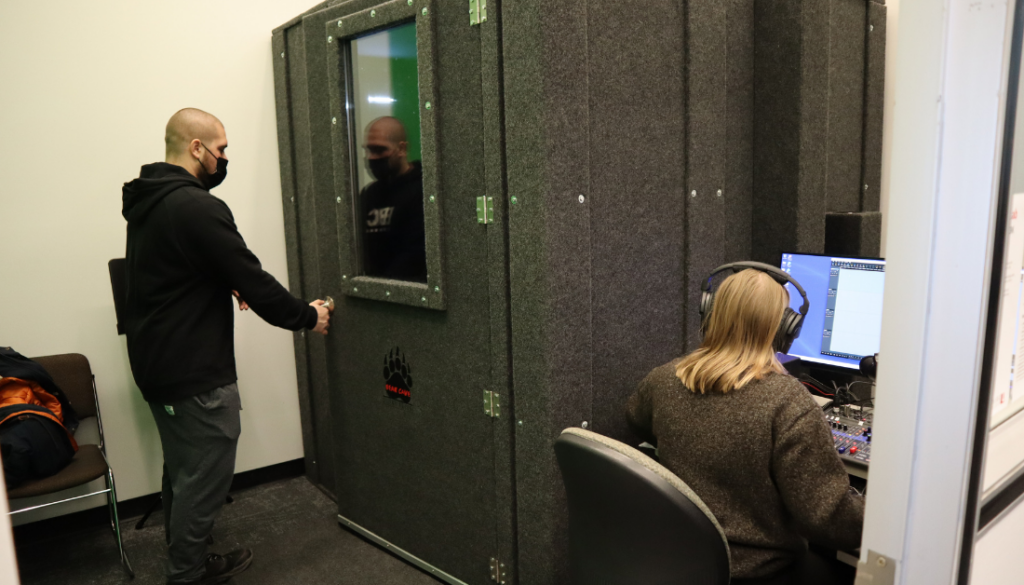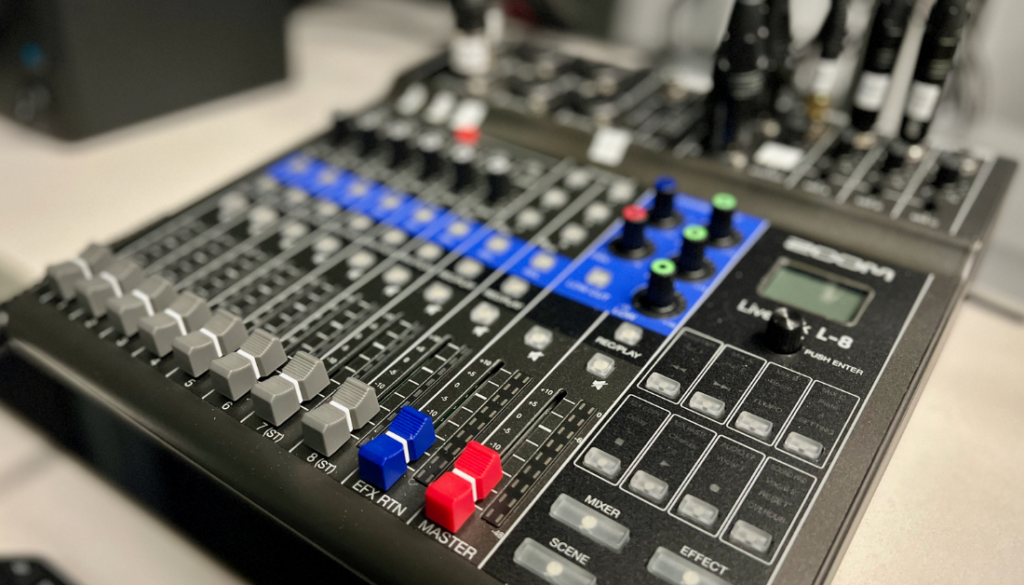The Media Creation Lab at YorkU Offers Users Access to Sound Booth
Whether you’re a student looking to submit your assignment in a more creative way by creating a podcast or a faculty member trying to create new ways to learn, the Bear Cave silent booth in the new Media Creation Lab (MCL) at Scott Library can help provide new ways to capture and work with audio. Installed in February, the audio recording booth is an important addition to the media creation resources provided for students and instructors who are creating multimedia as part of learning, research, or teaching.
Podcasts can be very useful pedagogical tools to capture group discussion and to develop communication skills according to Kris Joseph, digital scholarship librarian at York University Libraries. They can also help students develop writing skills through scripting and presenting research in a journalistic or editorial piece.
“Podcasts can also help with developing creative writing skills through the production of audio plays,” says Joseph.
"Podcasts can also help with developing creative writing skills through the production of audio plays."
Kris Joseph, digital scholarship librarian at York University Libraries
“In the long term, MCL’s goal is to become a fundamental part of York’s signature teaching environment by supporting media-focused Experiential Education and future eLearning projects, including the creation of multimedia Open Educational Resources,” says Joy Kirchner, dean of Libraries.
Joseph provides insight on the lab’s new audio recording space and offers tips to create podcasts using the lab’s new Bear Cave silent booth.
1.What are the benefits of creating a podcast for teaching or learning?
The creation of podcasts gives students an alternate way to express themselves and record their assignments rather than just writing them, as some students are more comfortable expressing themselves orally. It’s a different way to produce scholarship, and they get more excited and motivated about their projects and coursework. Undergraduate students might be hesitant to share a written assignment, but when they create a video or a podcast, they are more excited to share it with other students and publish it online. It propels the idea that students are teaching one another and that it is peer based.
Different faculties are asking students to do podcasts or audio projects as part of their coursework. Sometimes instructors give students the option either to write a paper or have a media-based assignment.
2. How can podcasts be used by faculty or students?
We have had requests from Arts, Media, Performance and Design (AMPD) students, Public History, Humanities, the office of student wellness, and gender studies. One request came from a philosophy class on rhetoric, and their whole idea was to use rhetorical devices to persuade people with an argument. So, the idea of having a debate made sense, and they wanted to record the debates in the form of a podcast.
3. Why did you choose to work with Bear Cave?
We chose to work with Bear Cave Silent Booths – an indigenous-owned company based in St. Catherine’s, Ontario – because they are local experts with experience and expertise in the creation of sound booths. They were able to provide us with a turnkey solution for our studio in the form of a standalone booth that can be moved to another location as our spaces evolve. The booth is designed to provide terrific sound quality, and we could start using it for recording as soon as we had it onsite.
4. How do you use the booth?
Our hands-on library staff provide training to help first-time users learn how to operate the booth and the equipment. We also have beginner friendly guides on how to record audio and create podcasts available on the MCL website.
The audio recording studio is set up with microphones, a computer, and a sound board. There is no need to bring any other equipment, but users can also just book time in the booth to record things on their own devices, because they’ll get nice clean audio.
5. What are the features of the booth?
The booth can accommodate up to three people. It is a 6 x 6 foot, wheelchair-accessible sound booth that provides 65 decibels of sound attenuation. It has up to three microphones, each with a music stand, light, and monitoring headset. Users can record separate tracks for each microphone using the Zoom LiveTrak-8 mixing board, and there is a computer workstation for monitoring, recording, and editing.
6. What are your top three tips when creating podcasts?
- Always make sure you set your recording levels before you record and test them before you hit the record button. You don’t want to lose an interview or an hour’s work because you didn’t test your equipment.
- Don’t be afraid to be quiet and leave long gaps while recording because you can always trim the spaces out while editing.
- Use multiple microphones if you are doing an interview. This gives the option of having two separate audio tracks and you can edit each track separately. Even if two people talk over each other while you’re recording, you can use the individual audio tracks to separate the speech in editing so you can hear both sides clearly.
7. Can anyone book the booth such as staff instructors, for example? How many students can use the booth?
Anyone with library privileges can use the MCL. It is accessible to undergraduate and graduate students, faculty members, librarians and archivists, instructors and York staff who are looking to incorporate multimedia eLearning components into their work. We are also exploring ways to give community engaged partners access to it as well.
We do give priority access to students and faculty members who are creating audio or video content as part of coursework or capstone programs (such as the C4 program). However, the spaces are intended to be accessible to all and welcoming to beginners, and we encourage anyone who wants to learn how to use the studio and get a feel for how the technology works to book and come try it out.
I would advise anyone wanting to record a podcast to book a day at the recording studio, and then book some time in the computer lab to use the resources available for editing their work. We have student staff who can help with any questions and provide support on how to use the tools and resources.
8. How can students book the sound booth?
Students can go to the Media Creation Lab website and select the “book audio recording studio” button. It will show them the studio’s availability, and they can choose their time and book a session online. We tried to design a straightforward process.


